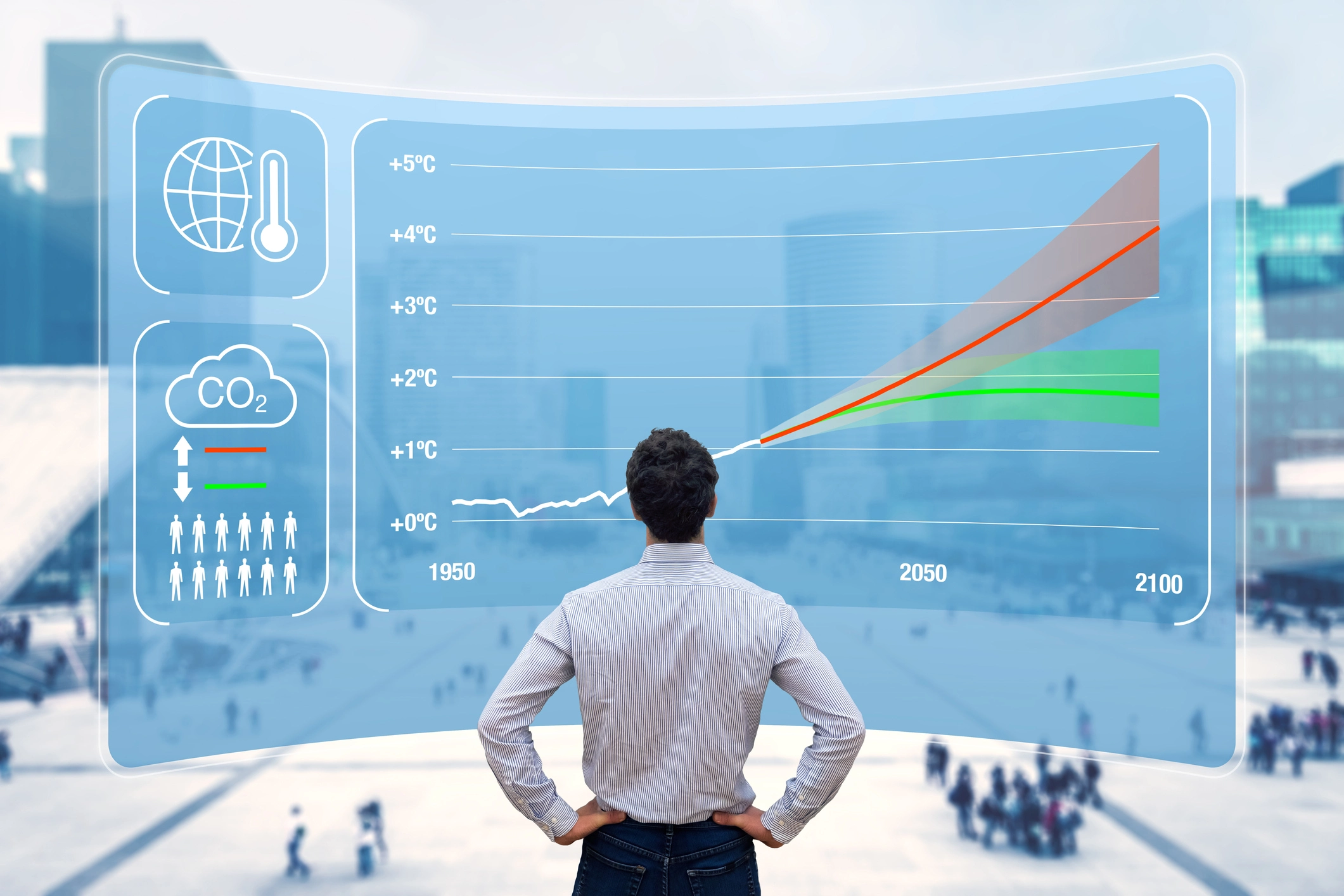

The road to net zero demands new insights, frameworks and investment strategies, both to tackle the challenges that transition presents and unlock the opportunities it affords.
It also requires recognition that the journey may not be a smooth one. Indeed, where one is currently headed may not equate to the destination one is trying to reach. Confusing aspiration with reality can have a significant impact on strategy, pricing and returns.
“In recent years, our industry has been mostly focused on viewing everything through the lens of a 2050 net-zero transition,” says Jeremy Lawson, chief economist at abrdn. “2050 is absolutely the right goal from a social and environmental perspective. But you don’t need to be an expert in climate policy to know that the world is absolutely not on that trajectory.
“Benchmarking against a timeline that doesn’t materialise may have serious implications for your return profile. Ultimately, asset prices will conform to the reality we’re in, not the one we’d like to see.”
In Lawson’s view, targets such as 2050 are a useful tool for spurring action, but can also serve as an easy shorthand for making the right noises about decarbonising one’s portfolio, without having to face up to its requirements.
While at pains to stress he is a realist rather than a cynic, abrdn’s chief economist acknowledges that his time working in politics – Lawson formerly served as a climate policy advisor to Kevin Rudd during his first successful campaign to be Australian prime minister, and later worked as a senior economist at the OECD – has generated a healthy suspicion of headline-grabbing targets.
Acknowledge reality
“Public policy is all targets – politicians absolutely love them,” he says. “But they mean nothing unless they’re credible. Within the investment community, much of the focus remains on complementing and facilitating Paris alignment, so even acknowledging that we’re on a different pathway can be challenging.”
Indeed, Lawson’s takeaway from last year’s Cop26 was that too much emphasis remained on “working backwards from targets” amid a general reluctance to acknowledge the scale of the challenges and gaps that still existed.
To this end, abrdn has developed what it identifies as “a unique approach to climate scenario analysis”, building bespoke scenarios that allow for a degree of nuance, flexibility and variety not typically available through their off-the-shelf equivalents.
This work has been a collaborative effort between abrdn’s Research Institute, a global team of economists and researchers, headed by Lawson, and other climate experts across the firm.
“As global ambition has increased and industry initiatives gather steam, the requirement for deeper analytical work around climate has grown,” he says. “We’ve been very focused on how to generate those insights on climate and transition impacts that are different from what other houses have been doing and integrate those factors into decision-making and products in a way standard tools cannot.”
The themes of nuance, flexibility and honesty crop up time and again. Lawson insists that acknowledging we are not on the path to 2050 is a constructive, rather than reductive, message. It does not mean abandoning climate goals; rather understanding what is probable, what the consequences might be, and adapting investment strategies accordingly.
“Partly because of the resources available and partly because of organisational goals that have been set, the focus has typically been what happens in an orderly transition, a disorderly transition, or if no progress is made,” Lawson says of traditional transition scenario modelling. “It’s all very focused on climate as tail risk.
“If you look at our scenarios, we account for these tail factors, but we go beyond that to look at the messy middle; the bulk of the probability mass that sits between the extremes.”
The abrdn Climate Scenario Analysis: A Rigorous Framework for Managing Climate Financial Risks and Opportunities white paper takes a closer look at what those efforts look like, while future articles in this series will expand on further steps abrdn is making to facilitate the transition, while managing the risks and opportunities that will arise along the journey.
An honest dialogue
For asset owners who have strongly aligned 2050 into their business plans, a focus on such nuance and detail might conflict with their overarching goals, but Lawson insists that those truly committed to decarbonisation are receptive.
“I’ve found the response very positive,” he says. “This probabilistic way of thinking about the future generates different insights into their exposures… We’re now in a position to have a more sophisticated conversation than others.
“It’s not a question of telling owners that they shouldn’t have a 2050 target; instead, it is about helping them understand the consequences of various pathways. Also, different owners have different goals and this is not a one-size-fits-all approach. We are keen to find ways of having richer, more credible conversations and that’s something which is appreciated.”
The sheer complexity and number of factors involved in defining any given pathway means that any given scenario must be adaptable enough to reflect new developments, disruptions and data.
“What happens if there’s a change in government that comes in with a new climate approach?” Lawson asks. “What about a technological breakthrough that sees a sharp fall in the price of solar PVs [photovoltaics] or battery capabilities in transportation? We have to be able to draw on multiple scenarios, far more that asset managers would typically use, weighted for probability. That, in turn, informs policy design.”
The degree of educated guesswork required across such a long time frame means generating multiple climate scenarios essential. Lawson acknowledges the challenge of forecasting technological change across a 30-year period, for example, citing how expert estimates around solar and onshore wind made only ten years ago fell well short of the reality.
“We do these runs where we’ll model based on an assumption that’s very favourable to, say, solar, forecasting the price of technology continues to fall,” he says of building nuance into their analysis. “But we must also model for what happens if that does not occur, but carbon capture and storage technologies become more viable and scalable. Both can be consistent with a particular climate pathway, but they will have quite different implications for factors like usage of natural gas and valuation of various companies.
“We can assign a probability to both scenarios and, as time passes, that weighting might change as we don’t see the developments or stages along the journey we might have expected to see. It’s about reviewing the evidence and questioning assumptions, learning and adapting to changes on the ground.”
Known unknowns
That flexibility must also extend to a recognition that developments in the market, be they technological, regulatory or political, will also see many companies – and their value propositions – evolve accordingly, something that is not always recognised in traditional modelling.
“In a typical climate scenario analysis run, companies are seen as passive actors as the world around them is changing,” Lawson explains. “But we know business strategies also adapt and that needs to be reflected. Something we’re now doing is incorporating companies’ transition plans into the scenario analysis, ranking them for credibility and then layering those results to create new perspectives.”
In creating sustainable returns for clients, there is also the challenge of balancing the long and short-term view. Lawson points to such a tension being created by the recent surge in fossil fuel prices and says it again comes down to flexibility and building a framework that enables investors to also take account of the current cycle.
“Credibility is key,” says Lawson. “If we can provide a more rigorous, detailed picture of what’s really going on, it will build better relationships and create far greater impact.
“Overshooting the Paris objectives on net zero is by far the most likely outcome at present and to become more positive would require quite a radical and credible shift in the global policy environment. The current likelihood is net zero won’t happen by 2050, but it will happen eventually. If we don’t get there until 2080, that’s obviously a far more dangerous world. In that instance, we would be looking at warming of closer to 2.3˚C.
“That’s twice as much warming as we’ve already seen. It will require trillions in additional spending on adaptation measures. By acknowledging the pathway we’re on, not just where we’d like to be, we can start to make that financing available earlier. We should always be aiming for the fastest transition possible, putting pressure on governments and markets to drive change, but we also have to prepare for what happens if we don’t get there in time.”







